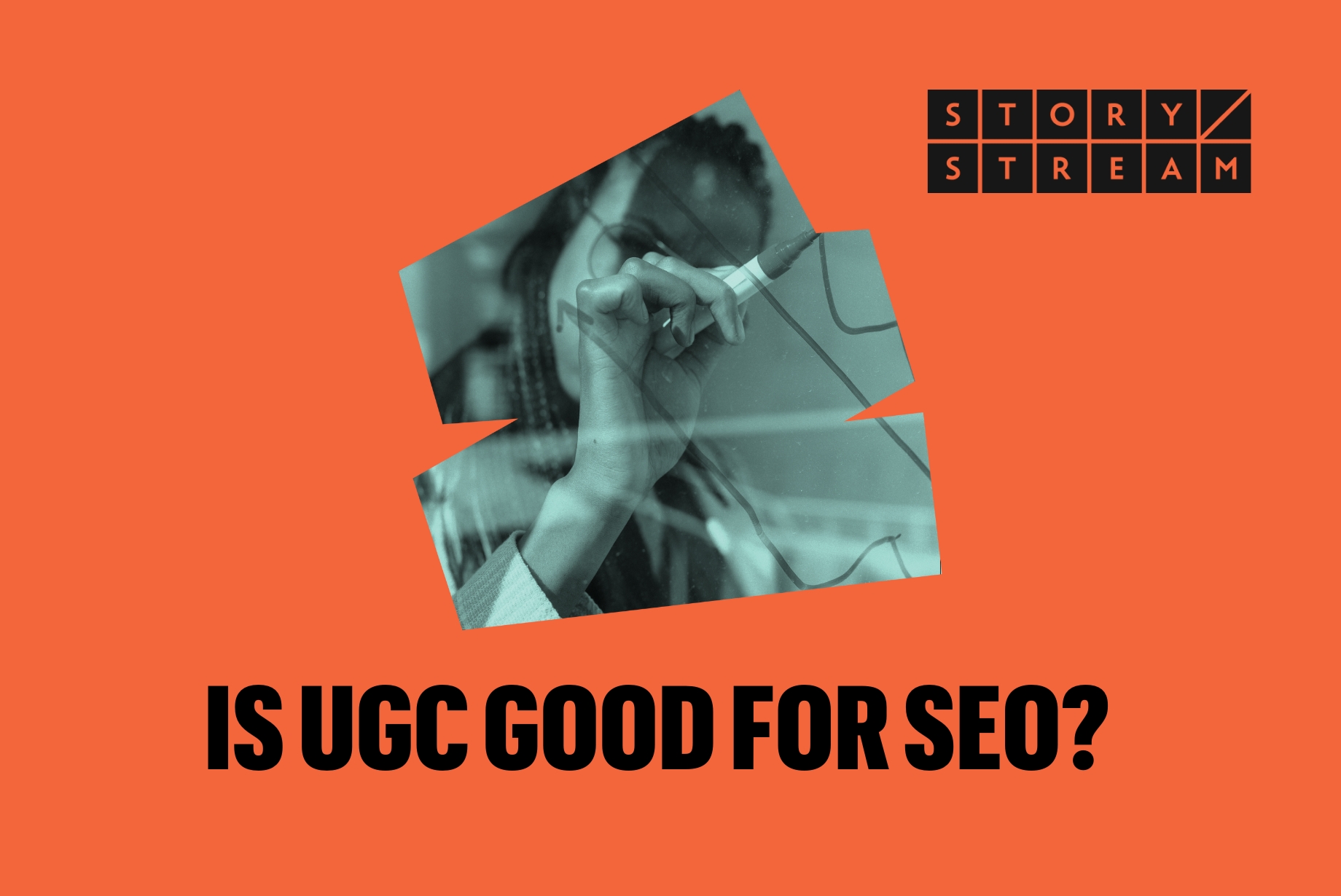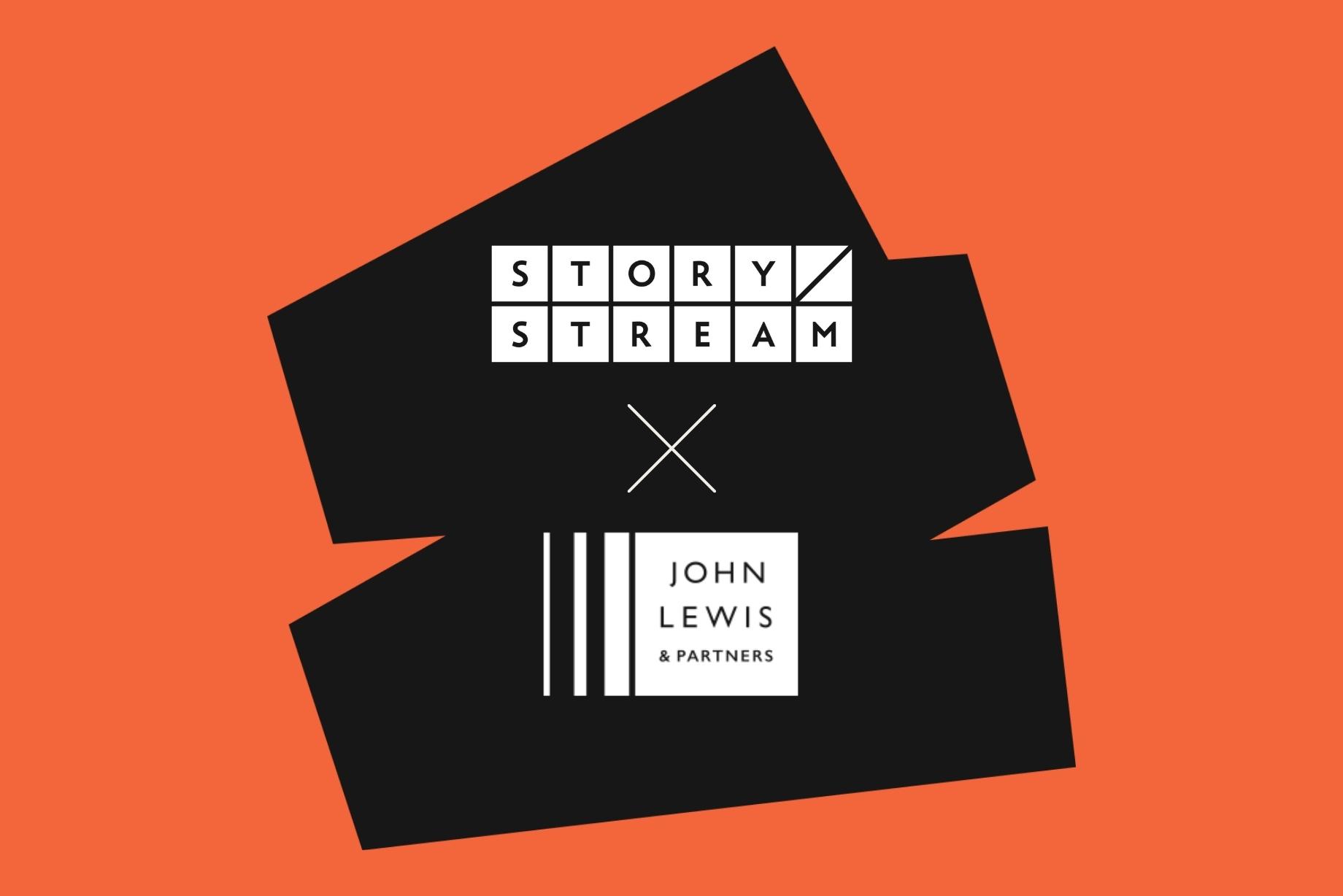SEO is a world where fine margins really matter. As search engines continue to evolve – what a user sees on a typical Search Engine Results Page (SERP) today can be almost unrecognisable compared to the same search even a year ago – so too do the rules of optimisation. Best practice can be a tough matter to define.
While User-generated Content (UGC) might at first feel like an unlikely ally in SEO, our research shows that there are a suite of demonstrable benefits that UGC can offer to a brand that wants to increase its success on SERPS.
With that in mind, allow us to introduce you to five ways that UGC can boost your organic search strategy. Let’s do it!
Turn Up the Volume: User-generated Content Significantly Increases Indexable Content
There have been many pretenders to the crown over the years, but as any SEO will tell you: content is still king. And when it comes to optimising content to be indexed by search engines, the consensus is that satisfying the requirements of “E-A-T” (i.e. expertise, authoritativeness, and trustworthiness) stands you in the best possible stead for climbing up the Search Engine Results Pages (SERPs).
The upshot for content marketers, therefore, remains “produce more, and better-optimised” content. Easy enough to say, but not quite so straightforward to achieve: the time and resources required to effect a multi-channel content marketing strategy (web, email, social media, paid search and social, etc.) and across a range of campaigns and always-on beats simultaneously are often so great as to make “optimisation” in of itself feel like a luxury. Produce more content? Sure. But produce more content that comes from a demonstrably expert, authoritative, and trustworthy point of view? Pretty tough!
For marketers looking to publish more (and more expert, authoritative, and trustworthy) content, User-generated Content represents a huge potential opportunity for increasing the stock of indexable, SERP-loved content.
UGC is an example of social proof, i.e. an example contained within a brand’s marketing of a customer getting value from/enjoying the experience of a product they’ve purchased. Social proof signals to a shopper that others who have gone before have had a positive experience. This is crucial context for a consumer – recent research from the IMRG shows that 73% of online shoppers said have been directly influenced by social proof in their online purchase decision-making – and can make for fantastic content for SEO. How? Let’s use an example…
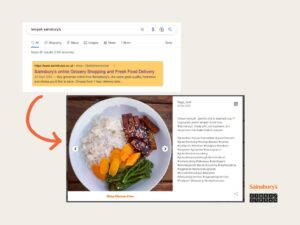
Here we have a good example of a dynamic SERP – i.e. results change seemingly by the hour! What’s interesting about it is how often we see User-generated Content appearing in the top three places on searches for “Tempeh Sainsbury’s” and close variants (over 200 total monthly searches). Fully shoppable on click, the UGC is helping Sainsbury’s rank for more spots at the top of the SERP.
How it works: with a StoryStream gallery enabled on-site, Google is able to crawl and index not only page-level descriptions (i.e. your page title and description) but will also crawl and index individual content items within the StoryStream galleries themselves. As a result, the volume of indexable content associated with a webpage increases, meaning websites have a much higher likelihood of appearing in relevant search results after implementing StoryStream.
Think Long-tail: UGC Gives You a Greater Depth of Keywords
Within the world of SEO, there are three main categories of search queries: “the fat head”, “the chunky middle”, and “long tail” (more on that on Ahrefs). These are situated along what’s sometimes called “The Search Demand Curve”, which looks like this:
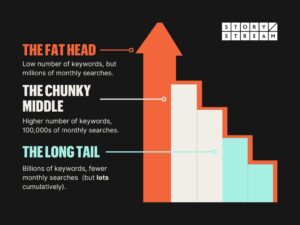
“The Fat Head” describes the relatively limited, very important phrases that attract significantly high volumes of searches (i.e. millions) each month. All things optimised and appearing at the top of the SERP, “Fat Head” keywords will typically return the highest volume of traffic for your website. Keywords in this bracket might be popular generic terms (e.g. “coffee” – 16 million searches monthly), or may just be your brand’s name (“Amazon” recorded 349 million searches per month in 2022).
In some cases, you may find yourself winning significantly more impressions on “Fat Head” searches than you are clicks – not necessarily cause for concern. It might be that your content is being served in a SERP feature, and so the information you’re providing is satisfying a user’s need without them having to click through to your site. (More on SERP features later.)
“The Chunky Middle” describes the millions of search queries that attract thousands or tens of thousands of searches each month. “Chunky Middle” terms may be lower in volume, but the sheer quantity of them (and quality of searches – the more specific a keyword is, the better the odds of your content matching their intent) means that having a strategy to hoover up as many as possible will be advantageous for your brand.
As opposed to “Fat Head” searches, “Chunky Middle” searches tend to run to 2–5 words, e.g. “Coffee shop near me” (60K monthly searches in the U.K.) or “bean to cup coffee machine” (33K monthly searches in the U.K.).
“The Long Tail” describes the billions – literally, billions – of search queries that, although limited in terms of individual profile (0–1000 average monthly searches), together represent a substantial portion of a well-optimised site’s traffic.
“Bean to cup coffee machine dual hopper” and “Bean to cup coffee machine touch screen” (110, and 50 monthly average searches respectively) are two good examples (of course; many, many more are available…).
It may be that utilising UGC can help your brand bolster its credentials for “Fat Head” and “Chunky Middle” terms (by, e.g. improving page dwell times on cornerstone pages on your site, pushing those pages up the rankings accordingly) – but it can be tricky to know that for certain.
What you can know about – and, in doing so, draw that direct causal line between UGC and SEO – is the effectiveness of User-generated Content in helping you rank for “Long Tail” keywords.
Why? Well, because customers get customers.
User-generated Content is fantastic not only for its status as the digital equivalent of “word of mouth” (promotion from customers on behalf of your brand is “earned”, and doubly effective as a sales tool) but also because of its tendency to contain detail; an array of detail that goes far beyond the form factors of a product specification, and gets right into how the product really looks, feels, and slots into (and, hopefully, improves) part of that person’s life.
A piece of UGC that considers the true benefits of a product will likely contain detail that’s missing from your brand’s own marketing (whether that be for sake of brevity on behalf of your brand, or simply because you hadn’t considered it in your planning – it happens!). And in that direction, a greater depth of keywords, and greater volume of Long Tail appeal, lies.
We see first-hand that websites with UGC galleries enabled will rank for a wider range of Long Tail keywords – increasing SERP coverage while winning traffic with a higher propensity to convert.
Page Takeovers: UGC Boosts Brand Presence in Search Engine Results
According to research conducted by Baclinko, the top three search results on a typical SERP account for 54.4% of all clicks. So while ranking in spot #1 remains a critically important factor for achieving organic search success (position one takes an average of 27.6% of clicks) – there’s still a significant number of clicks to be had outside the top spot.
For many brands – and regardless of whether or not they can boast a number one ranking against a keyword – increasing the number of pages that can appear for a keyword is an important part of their organic search strategy.
“How to” reference pages, glossaries, and content marketing blogs (hello!); these pages (sometimes referred to as “hygiene” pages) play a supporting role for cornerstone content. And when properly optimised, they can help a brand to establish dominance on the first page of a SERP.
And to that list of supporting pages primed to boost your Search appeal, you can add “User-generated Content”. Used in an SEO-friendly manner, UGC is a quick and effective way to add contextually relevant, rich results to your phalanx of supporting pages.
Consider for a moment a UGC hub. A hub is comprised of unique pieces of User-generated Content, organised around a theme (e.g. “Inspiration”) or collection of categories (e.g. “Autumn Looks”, “Winter Jumpers” etc.). Hubs display multiple items of UGC concurrently – but click into a content item, and you may notice that the URL in your browser’s address bar changes a little. That’s because each content item has a unique URL … and those URLs can be indexed by search engines and served on SERPs.
Happily, that same logic applies to product display pages. An example: search for “rainbow dog collar” and you may be served with a result to a lovely example of such on Boden.co.uk (unfortunately now out of stock!). Click on the result for Boden, and you’re greeted with this charming piece of User-generated Content:
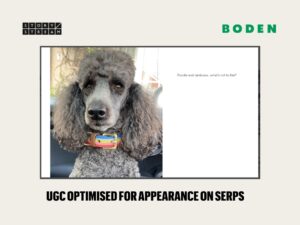
(That piece of UGC is Boden’s top-ranking entry for searches on “tan dog collar” and “rainbow dog collar” – more validation of UGC’s effectiveness for SEO!)
So, long story short: the more UGC you can have hosted in an SEO-friendly manner (don’t forget to add it to your sitemap!) means the more individual URLs that are available to rank – giving brands the potential for a much larger presence on results pages than competitors, and a higher likelihood of winning clicks.
Space Invaders: UGC Helps You Rank for SERP Features
What if I told you that Google+ never really went away and that really Google+ has just become your SERP? Hyperbole aside, you will have noticed that an increasing number of search engine results pages look and feel like a social network.
For example, searches for “Harry Styles” on Google – 6 million every month! – are served with a cornucopia of informational formats:
- A knowledge panel replete with biographical details
- Tour concert dates
- A “People also ask” accordion
- “Top stories” from news and media outlets
- A “Movies” breakout
- A carousal of YouTube videos
- “Related searches” (no sign of Zayn, for shame)
- And even a feed of Harry’s latest Tweets!
Each of these boxes of rich content is what’s known as a “SERP feature”. And – good news! – User-generated Content can increase your chances of ranking for them.
Take, for example, the “image pack”. On occasions where Google believes the user’s intent will be satisfied best by imagery, the search engine results page will show thumbnails alongside or ahead of text results. As many as 39% of keywords feature an image pack in the SERP – so the value of ranking highly within the Google Images portion of the SERP can be much higher than you might expect.
User-generated Content is content that’s primed for earning an appearance within “image pack” SERP features. Properly annotated – at a meta-description level, always remember: alt text is your friend – and accompanied by a descriptive URL, UGC can be recognised by search engines and served as part of the image pack – increasing your visibility in an important part of the search engine result page, and further improving your chances of the winning the click.
Top tip: Backlinko’s research indicates that URLs containing terms similar to a keyword have a 45% higher CTR compared to URLs that don’t contain a keyword.
Alongside “image packs”, search engines like Google will also select content from a page that it believes illustrates a link’s contents (whether within an image pack or not). An example of a result from Porsche.com on searches for “Taycan frozen blue”:
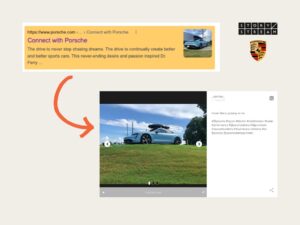
Here we see a piece of UGC (originally created by Instagram user _rsroman_) sitting alongside the text result – a strong signal that users are finding that User-generated Content (which, remember, you haven’t needed to brief a team to produce) helpful and illustrative.
Stick to It: UGC Increases Site Page Dwell Times
So far, we’ve covered how User-generated Content can help your brand with the on-SERP side of SEO … but what about on-site ranking factors? Well, here things get a little controversial.
Whether or not specific user interaction metrics (e.g. time on page/dwell time, bounce rate, pages per session, etc.) constitute a direct ranking factor is heavily debated. For example, while Bing will explicitly say that “dwell time” (i.e. time on page) is a signal they’re looking at when creating SERPs, Google will explicitly deny that it is. Case closed? Not quite – aside from what the search engines do or don’t say themselves there’s a whole cottage industry comprised of data scientists and SEOs looking for patterns between site performance factors and search appearance. And, you’ve guessed it, many of their studies draw links (while being keen to stress that correlation isn’t causation) between factors like “dwell time” and appearance in the topmost portions of SERPs.
This piece from Backlinko gets into the weeds of whether “dwell time” has an effect on search appearance, and concludes that the strength of evidence for “yes” outweighs any assertion to the contrary. Even anecdotally, it figures: a search engine’s rudimentary proposition is that it can retrieve for you, the user, the content that you want to see as quickly and conveniently as possible. A site that can boast a strong “dwell time” is sending a signal to search engines that others find the content useful – a signal a search engine would be remiss to ignore.
And for further avoidance of doubt, this chart from WordStream (published in an article from Moz) makes the point quite elegantly:
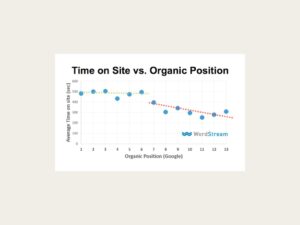
So if, and with renewed confidence, we can say that average time on site/dwell time is an important factor to get right in your SEO strategy – then what can you do to improve that metric for your site? There are plenty of good ideas (adding video, producing longer form content, structuring your pages around a hook, etc.) in the Backlinko piece, but one highly-influential factor they’ve missed: User-generated Content.
UGC has a proven impact on site dwell time. One of the core SEO benefits of using a platform like StoryStream is the demonstrated increase in dwell times – up to 400% in some instances – that we observe on our customers’ sites after implementation. Why? It’s simple: User-generated Content (which may be a video, an image, or even a review from a third-party entity) gives pages a greater depth of engaging, highly relevant content.
UGC encourages longer dwell times (i.e. more time spent on page), suggesting that a search result is more relevant to a user’s query. Over time, URLs associated with that page will climb the rankings.
Here we can return to the “E-A-T” model (expertise, authoritativeness, trustworthiness) first outlined in Google’s Search Quality Rater Guidelines, and used by SEOs today to quantify page quality. User-generated Content, a key form of social proof, is E-A-T content: authentic, trustworthy, and coming from a compelling place of authority – a real customer!
Summing Up
There are, if you can believe it, things we haven’t mentioned: publishing frequency and content freshness – two factors that a pipeline of UGC will deliver on well – are widely regarded to be significant factors in improving rankings in SERPs; the propensity of UGC to act as digital WOM, thereby increasing brand awareness (and searches!); the notion that UGC served in mobile-first experiences can help drive engagement and pass Google’s important benchmarking tests … the list goes on!
In short, the role that User-generated Content plays in SEO can be of critical importance. As a tactic for increasing your chances of appearing across a number of SERP features, UGC is another string to add to your bow. As a means for using customer advocacy to target niche keywords, UGC is well-placed to land a hand. And as a way to do all of that while not needing to invest even more in content optimised to improve your brand’s search appearance … UGC is indispensable.
Case made? Let us know what you thought of this article. And if finding the sweet spot between UGC and SEO is something you’re interested in hearing more about, contact the StoryStream team to organise a deeper dive.
